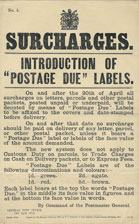
About this Website
This website describes The Postage Due Stamps of Great Britain, which were first issued in 1914. They were based on a design by George W. Eve which was in use until decimalisation in 1971, a period of some 57 years! Postage Dues continued after decimalisation with new designs by Jeffery Matthews and Sedley Place Design until they were withdrawn in 2000. The site spans the entire period of use.
The main reference work is the Stanley Gibbons Specialised Catalogue. Additional information is included from a variety of sources, see the bibliography. As with other sites in the same series, emphasis has been placed on providing good quality colour images, and as many as possible.
About the Images
The images on this website are from scans, some of my own collection, many ex Bob Murton, some have been supplied by other collectors and dealers, and some are taken from auction archives with permission from the auction houses. All are copyright, see the notice below. Most images have been improved with Photoshop. They have been straightened, cropped, etc, and minor damage has been repaired.
Thanks to the following for allowing use of their images:
Stanley Gibbons
Andrew G Lajer
Candlish McCleery Ltd
Grosvenor Philatelic Auctions
Spink & Son
and to The Postal Museum. None of the images on this site are from The Postal Museum but their documents and records were of great help.
Copyright Notice
This website and contents are copyright © 2018-2024, all rights reserved. Any use, redistribution, or reproduction for other than personal non-commercial reasons is prohibited. In addition, images from auction archives are protected by the copyright of the auction houses.
Let’s begin with a brief history …
The First Issue
The British Philatelist reported in April 1913 that Great Britain was at last to have a set of stamps for payment of charges on unpaid or underpaid letters. Then further noted that France had issued postage dues (10c. and 15c.) in January 1859; but better late than never! The report was based on a speech by Postmaster General Herbert Samuel in the House of Commons on 24 Apr 1913:
We are thinking of introducing also a system which prevails in almost every other Post Office, of collecting the charges for unpaid or underpaid letters by means of unpaid letter stamps in place of the present rather primitive method of writing or stamping the figure 1d or 2d on the envelope or card. The matter is still before the Treasury, and I have not yet got Treasury sanction, but I hope to obtain it before long. The Public then will know that the charge made to them is authorised, and I hope to effect some saving in the Accounting arrangements by this change.
The Postmaster General informed the Board of Inland Revenue in a letter of 28 Oct 1913, suggesting a tender for four denominations: ½d, 1d, 2d, and 5d; advising that G. W. Eve had been invited to prepare a design for the new labels (for a fee of Thirty Guineas); and requesting that the Board inform the Mint that dies and plates would be required.
Waterlow Brothers & Layton, Harrison & Sons, and De La Rue & Co responded to the tender. The latter saying that it would be impossible to print from plates other than their own, so their price included costs for dies and plates, which ruled them out. The lowest tender was from Harrison, and so they were awarded the contract.
On 31 Jan 1914, the GPO requested that, when a die has been prepared for any one of the denominations, essays in different colours be furnished. On 12 Feb, nineteen essays (colour trials) were supplied using the first plate received from the Mint (2d labels). Green, red, agate, and brown were chosen, and four denominations were issued on 20 Apr 1914: ½d (return-to-sender rate), 1d (double the postcard rate), 2d (double the letter rate), and 5d (double the foreign letter rate).
